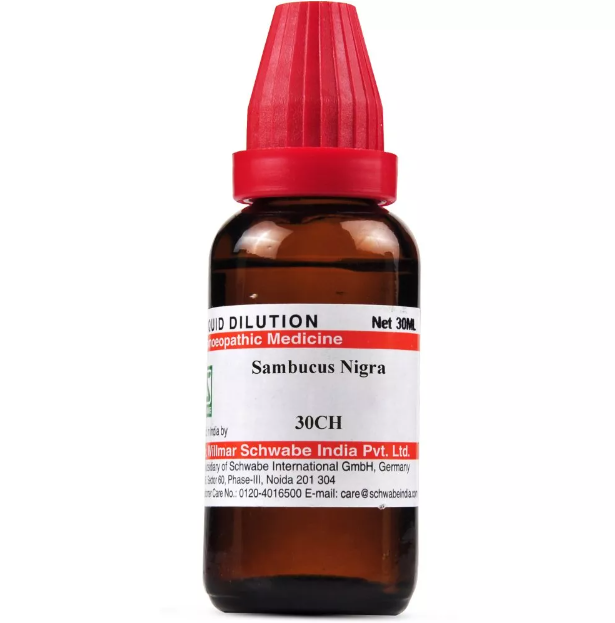SAMBUCUS NIGRA Q, 6C, 12C, 30C, 200C, 1M, 10M USES AND SYMPTOMS
 SAMBUCUS NIGRA
SAMBUCUS NIGRA
Samb.
Primarily affects the respiratory system. Common in infants with dry nasal congestion (snuffles) and swelling. Excessive sweating accompanies many conditions.
Mind:
Sees images when eyes are closed. Constant irritability, easily scared, followed by choking episodes.
Face:
Face turns blue during coughing. Red, burning spots on cheeks. Heat and sweating on the face.
Abdomen:
Nausea, flatulence, and colic, with frequent watery, slimy stools.
Urinary:
Excessive urination with dry skin heat. Frequent but scant urination. Acute kidney inflammation, dropsy with vomiting.
Respiratory:
Chest tightness, stomach pressure, and nausea. Hoarseness with thick mucus in the throat (laryngitis). Sudden, suffocating cough (bronchitis), often at midnight, with crying and difficulty breathing. Spasmodic croup (whooping cough). Dry nasal congestion in infants, blocked nose. Cough causes the child to stop nursing due to breathing difficulty. Child wakes up suddenly, almost suffocated, turns blue (cyanosed), struggles to exhale. Millar’s asthma.
Extremities:
Hands turn blue. Swelling in legs, insteps, and feet. Icy cold feet. Night sweats causing weakness (Salvia, Acet-ac.).
Fever:
Dry heat while sleeping. Fears uncovering. Sweats excessively while awake. Dry, deep cough precedes fever.
Skin:
Dry heat during sleep. Bloated, swollen, with general dropsy. Sweats heavily upon waking.
Modalities:
Worse during sleep, at rest, after eating fruit. Better sitting up, with movement.
Relationship:
Compare with: Ip., Meph., Op., Samb-c. (important in treating dropsy; requires large doses—fluid extract, 1/4 to 1 teaspoonful, three times daily).
Antidotes: Ars., Camph.
SYMPTOMS OF SAMBUCUS NIGRA
Mind:
Sees images when closing eyes.
Constant irritability.
Easily frightened, leading to choking or suffocating episodes.
Face:
Face turns blue during coughing.
Red, burning spots on cheeks.
Heat and sweating on the face.
Abdomen:
Nausea, flatulence, and colic.
Frequent watery and slimy stools.
Urinary:
Excessive urination with dry skin heat.
Frequent urination with small amounts.
Acute kidney inflammation with vomiting.
Dropsy (fluid retention).
Respiratory:
Dry nasal congestion (snuffles), especially in infants.
Tightness in the chest with nausea.
Hoarseness with thick mucus in the throat.
Sudden, suffocative cough (often at midnight).
Spasmodic croup (whooping cough).
Blocked nose causing difficulty breathing while nursing.
Child wakes up nearly suffocated, turning blue (cyanosed), and struggles to exhale (Millar’s asthma).
Extremities:
Hands turn blue.
Swelling in legs, feet, and insteps.
Feet feel icy cold.
Night sweats causing weakness.
Fever:
Dry heat during sleep.
Profuse sweating while awake.
Deep, dry cough preceding fever.
Skin:
Dry heat during sleep.
Bloated and swollen, with general dropsy.
Heavy sweating upon waking.
selection of the potency
Individualization:
- Homeopathy is based on the principle of treating the individual, not just the disease. The unique symptoms and characteristics of the person are crucial in determining the most suitable potency.
Intensity of Symptoms:
- The intensity of the symptoms guides the choice of potency. If the symptoms are intense and acute, a lower potency (e.g., 6C, 30C) might be considered. For chronic conditions with less intensity, higher potencies (e.g., 200C, 1M) may be appropriate.
Sensitivity of the Patient:
- Some individuals are more sensitive to homeopathic remedies, while others may require higher potencies. The practitioner considers the patient’s sensitivity when selecting the potency.
Acute vs. Chronic Conditions:
- Lower potencies are often used for acute conditions, while higher potencies may be considered for chronic or long-standing issues.
Previous Response to Potencies:
- The patient’s response to previous homeopathic treatments helps guide the choice of potency. If a particular potency has been effective in the past, it may be repeated or adjusted as needed.
Vital Force and Susceptibility:
- Homeopathy views illness as a disturbance in the vital force. The practitioner assesses the patient’s overall vitality and susceptibility to determine the appropriate potency.
Aggravation or Amelioration:
- The direction of the symptom response (aggravation or amelioration) after taking a remedy can influence the choice of potency.
Miasmatic Considerations:
- In classical homeopathy, the concept of miasms (inherited disease tendencies) is considered. The practitioner take this into account when selecting the potency.
Practitioner Experience:
- The experience and preference of the homeopathic practitioner play a role. Some practitioners may have success with certain potencies based on their clinical experience.
SAFETY INFORMATION
- Do not exceed the recommended dose by physician
- Keep out of the reach of children
- Store in a cool dry place away from direct sunlight
- Maintain half an hour gap between food/drink/any other medicines and homoeopathic medicine
- Avoid any strong smell in the mouth while taking medicine e.g. camphor, garlic, onion, coffee, hing
Medicine images use for reference only selection of homeopathic medicine depends on the individual’s specific symptoms and overall constitution. Moreover, homeopathy is a holistic system of medicine that treats the individual as a whole. In addition to addressing the physical symptoms, it takes into account the emotional and mental state of the person. Consequently, it’s crucial to consult with a qualified homeopathic practitioner for personalized treatment.
The information provided on this website is intended solely for educational purposes. Always seek the advice of your physician or other qualified health provider.
